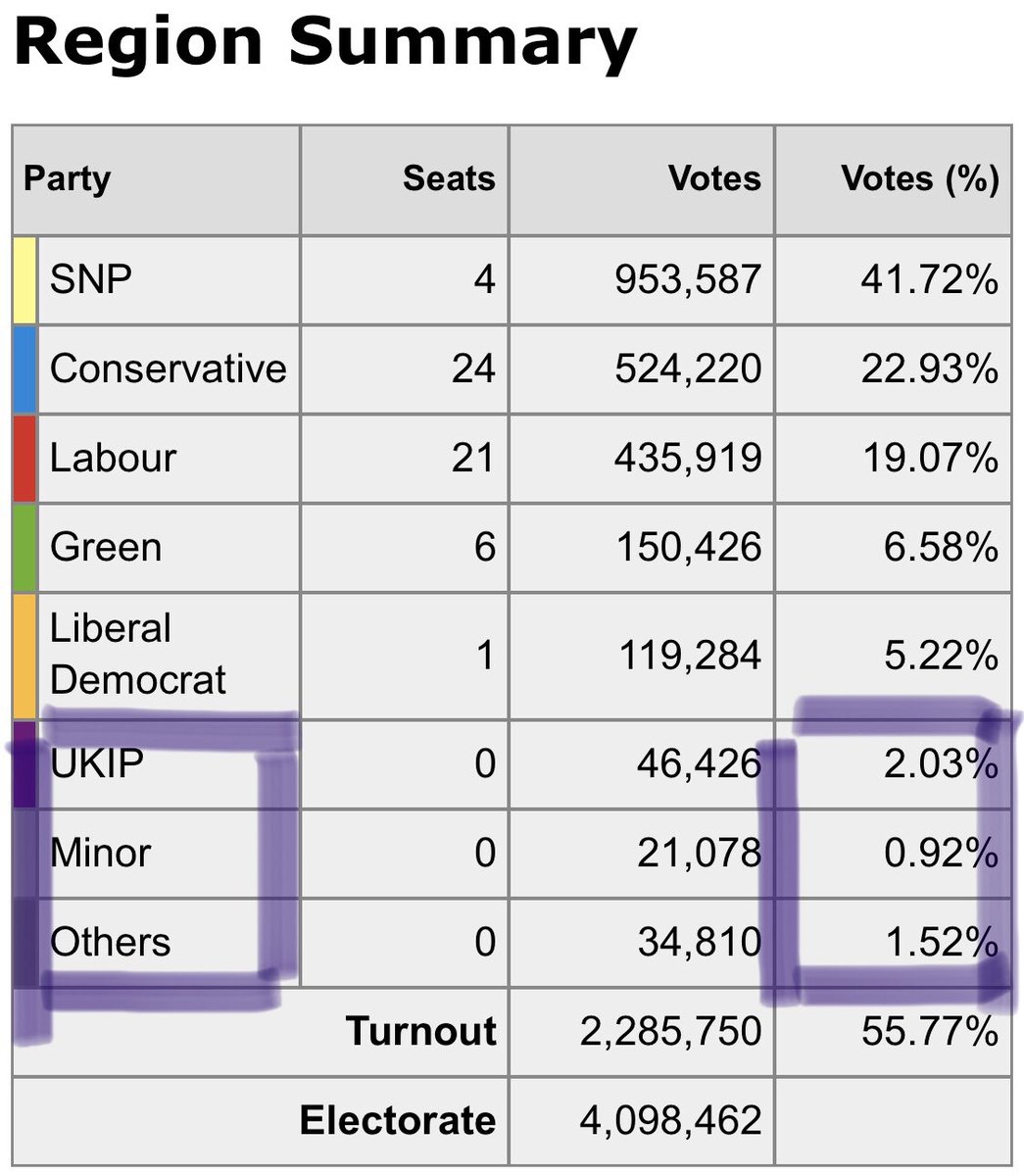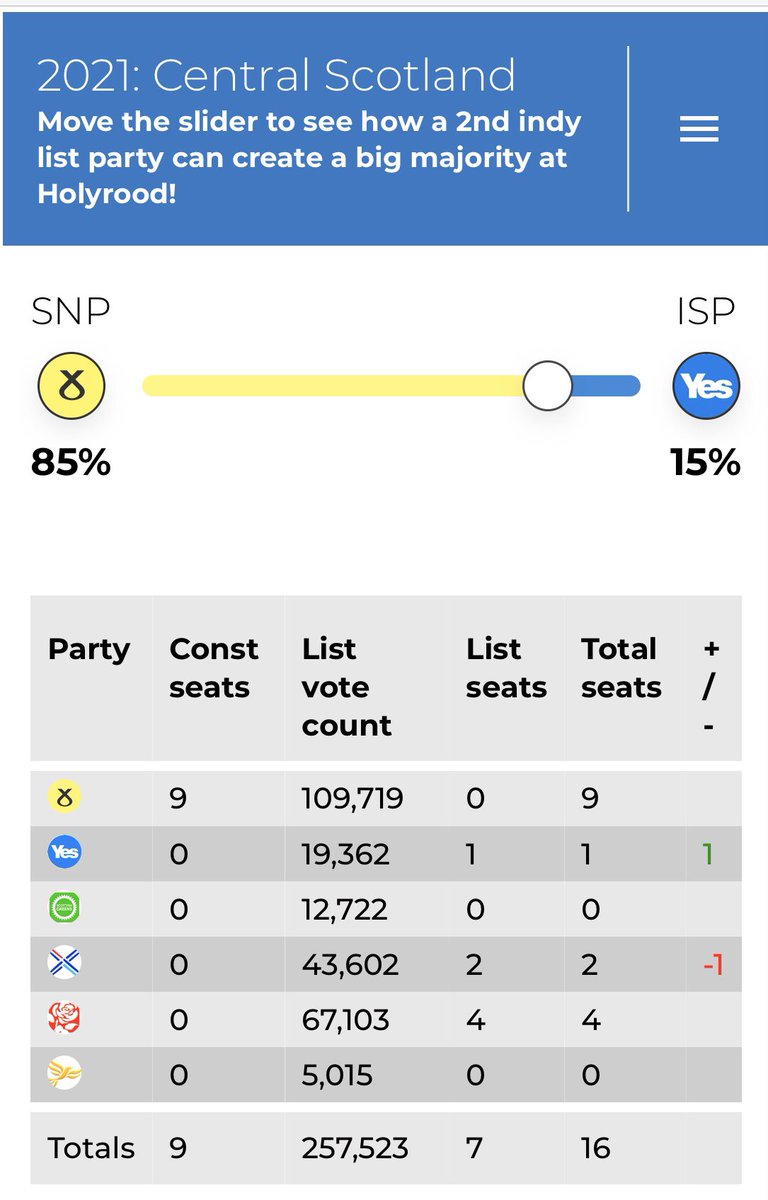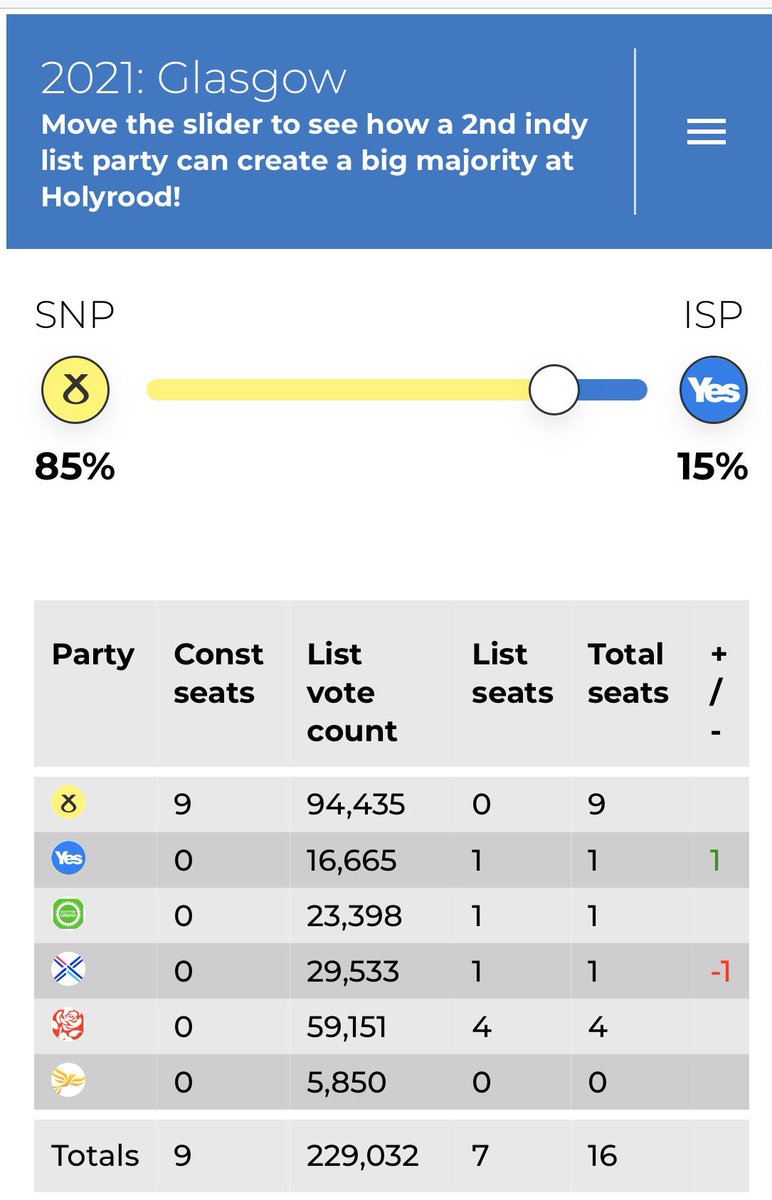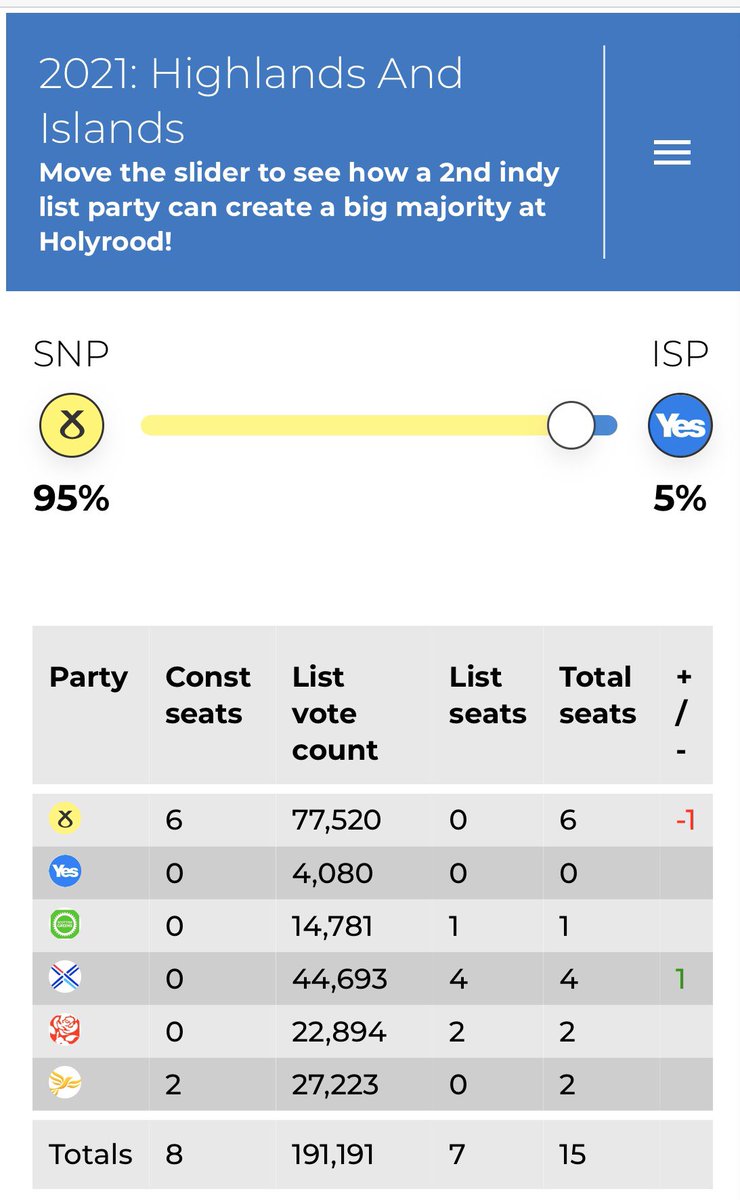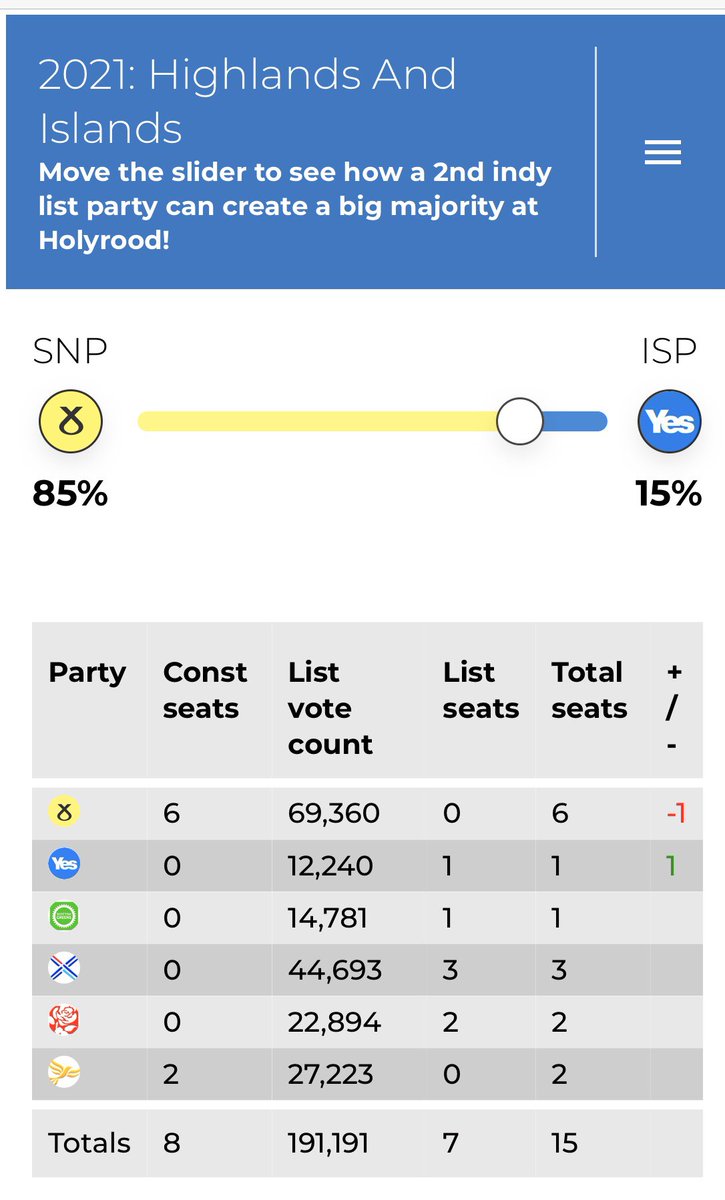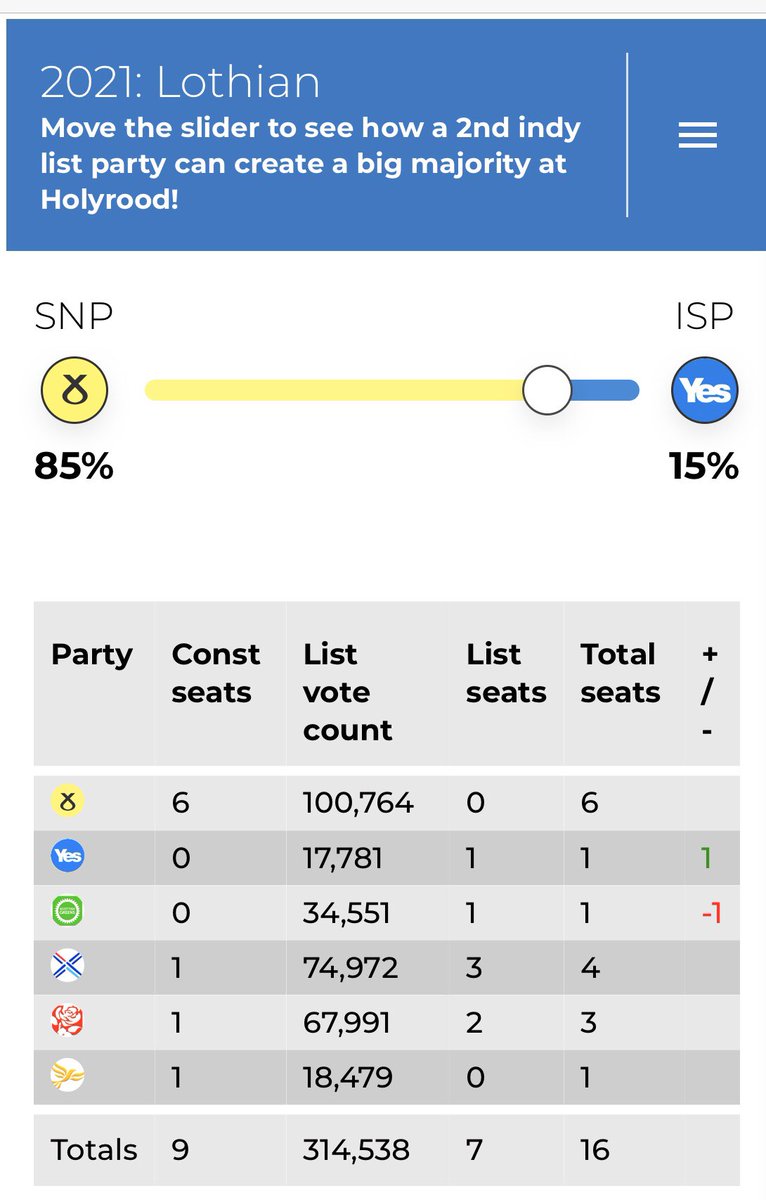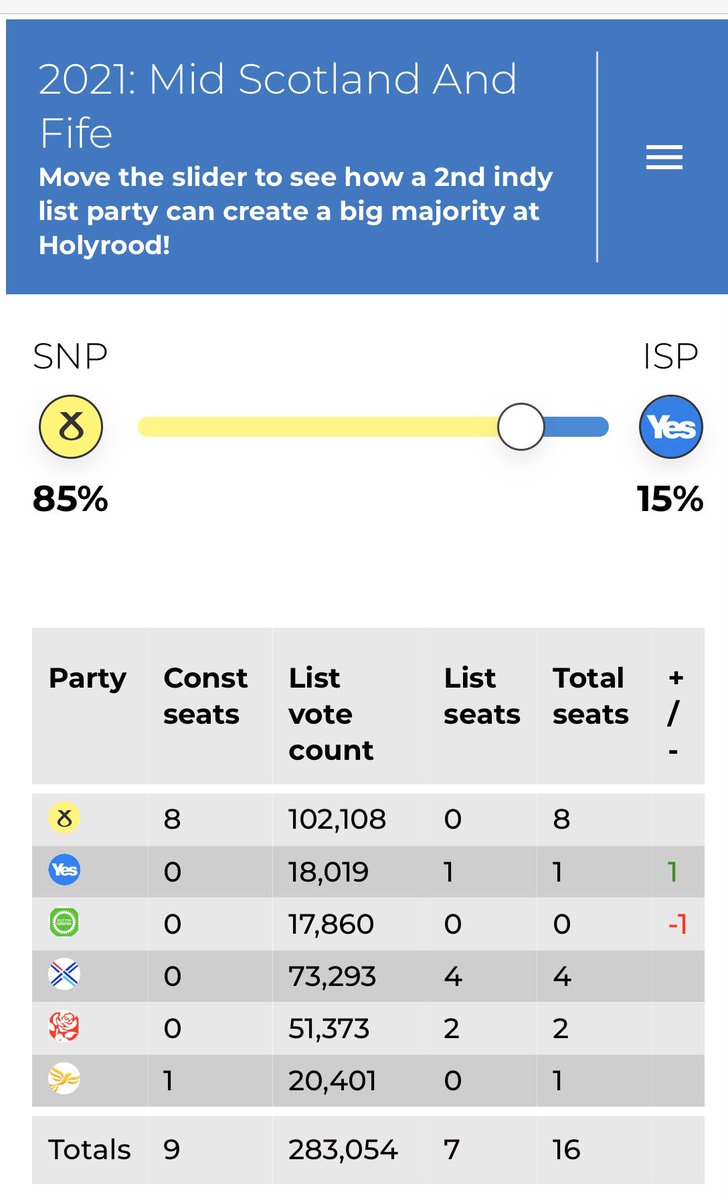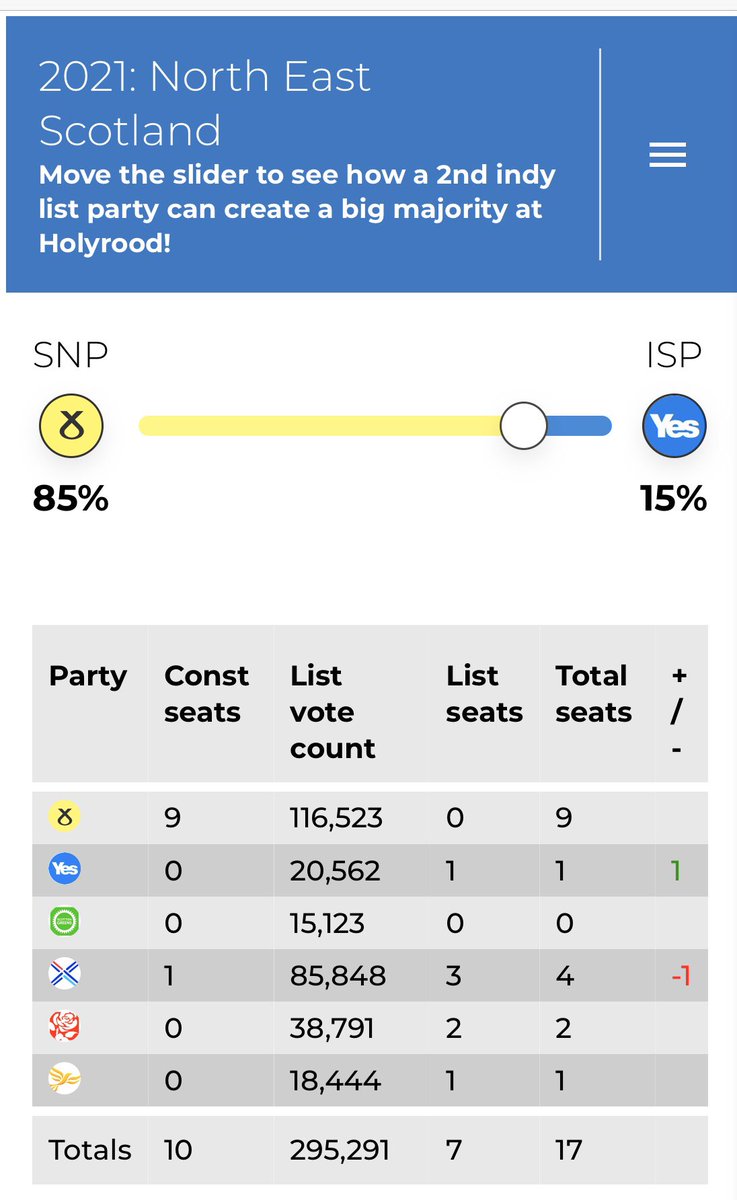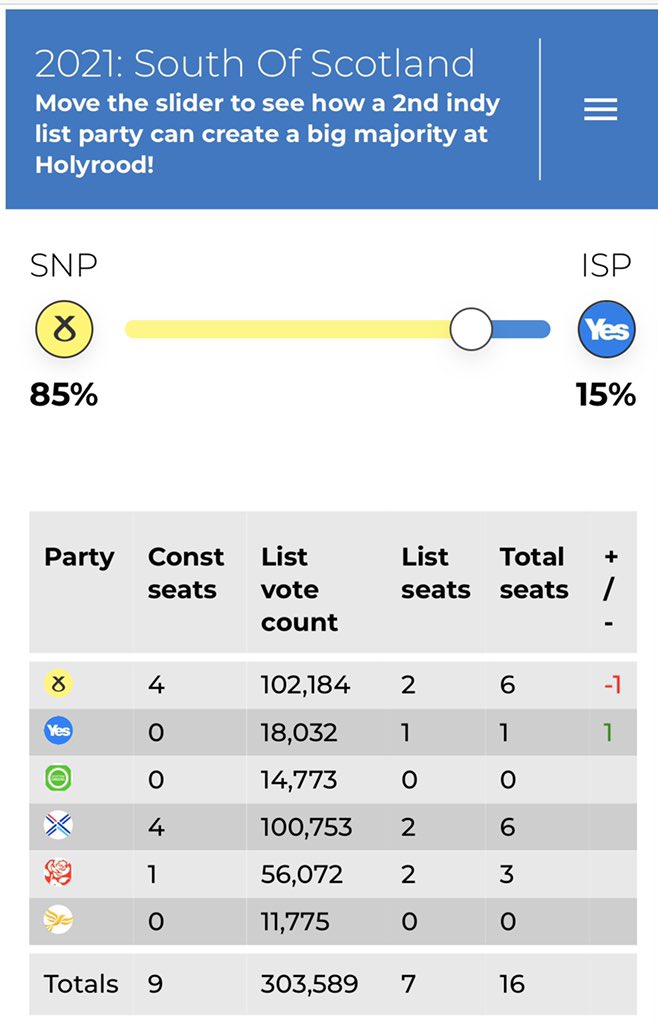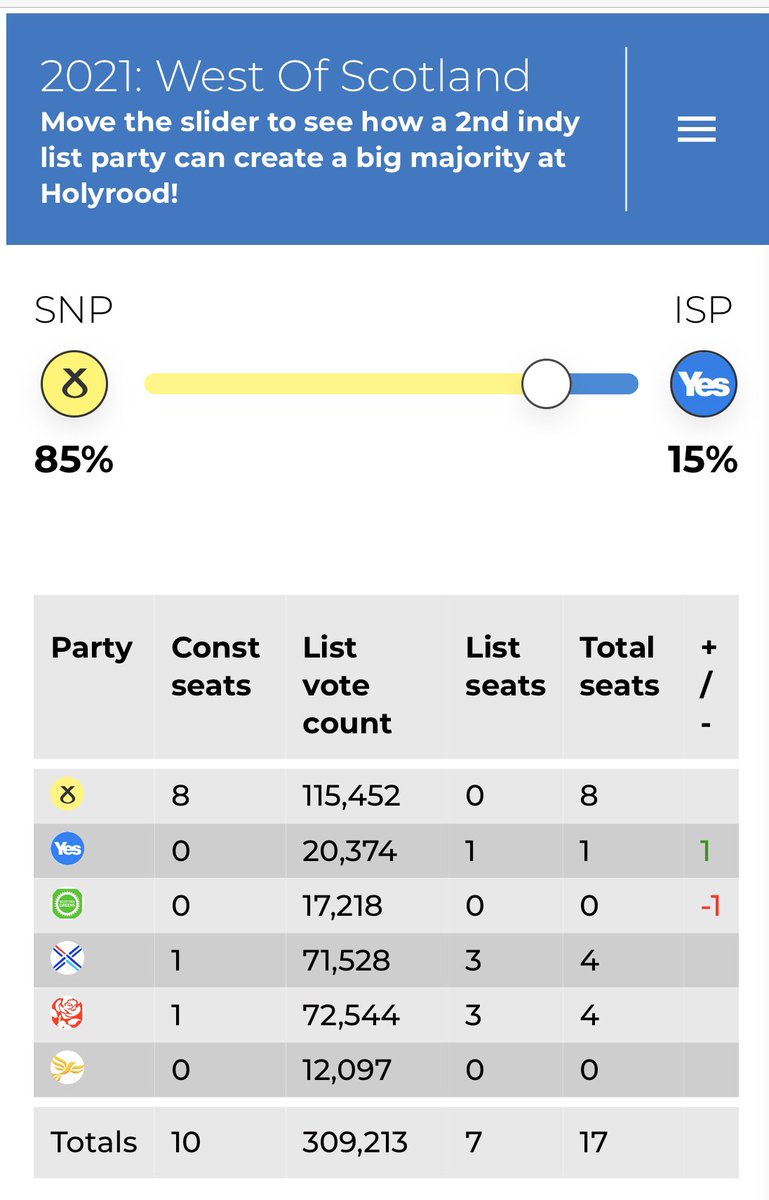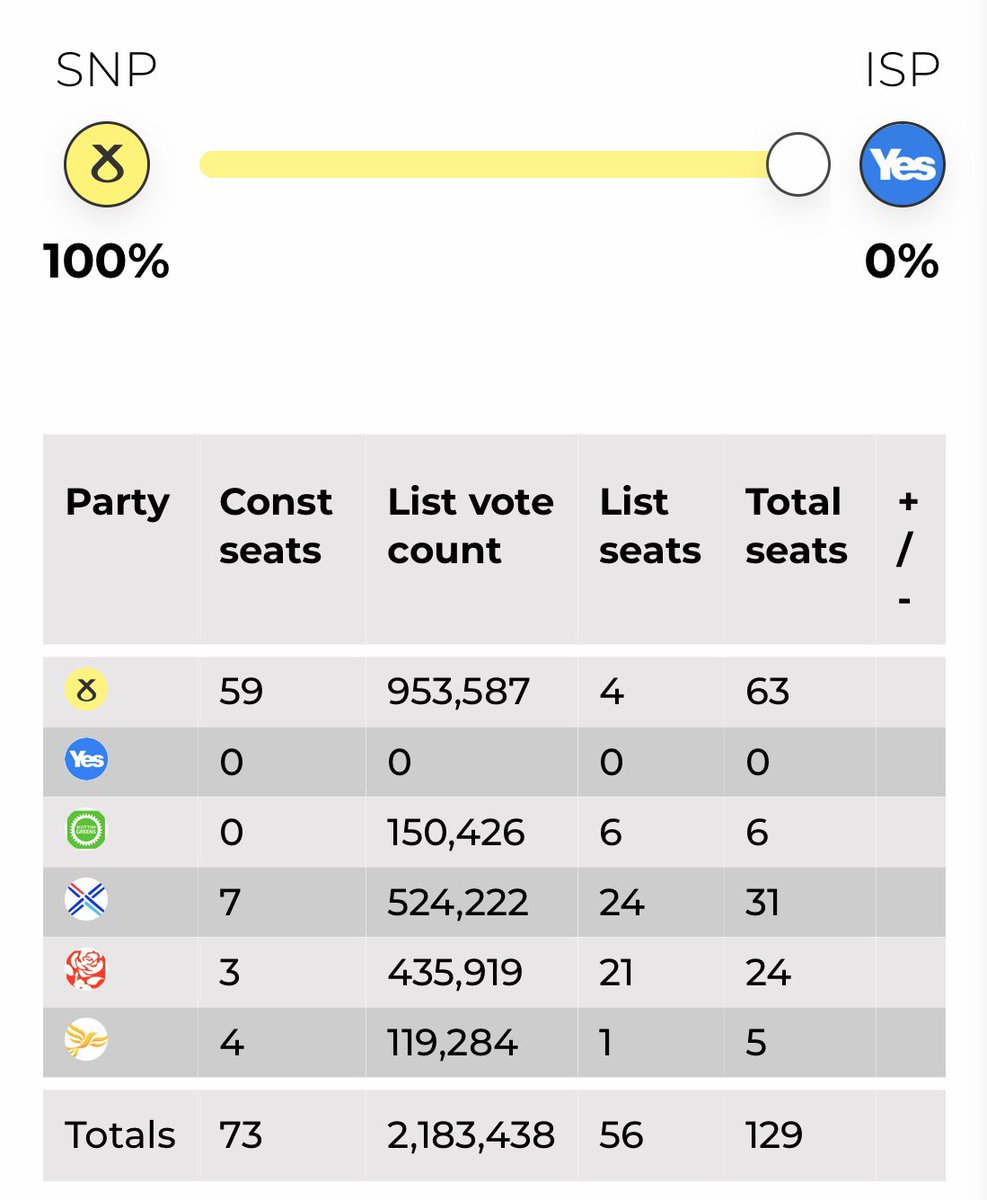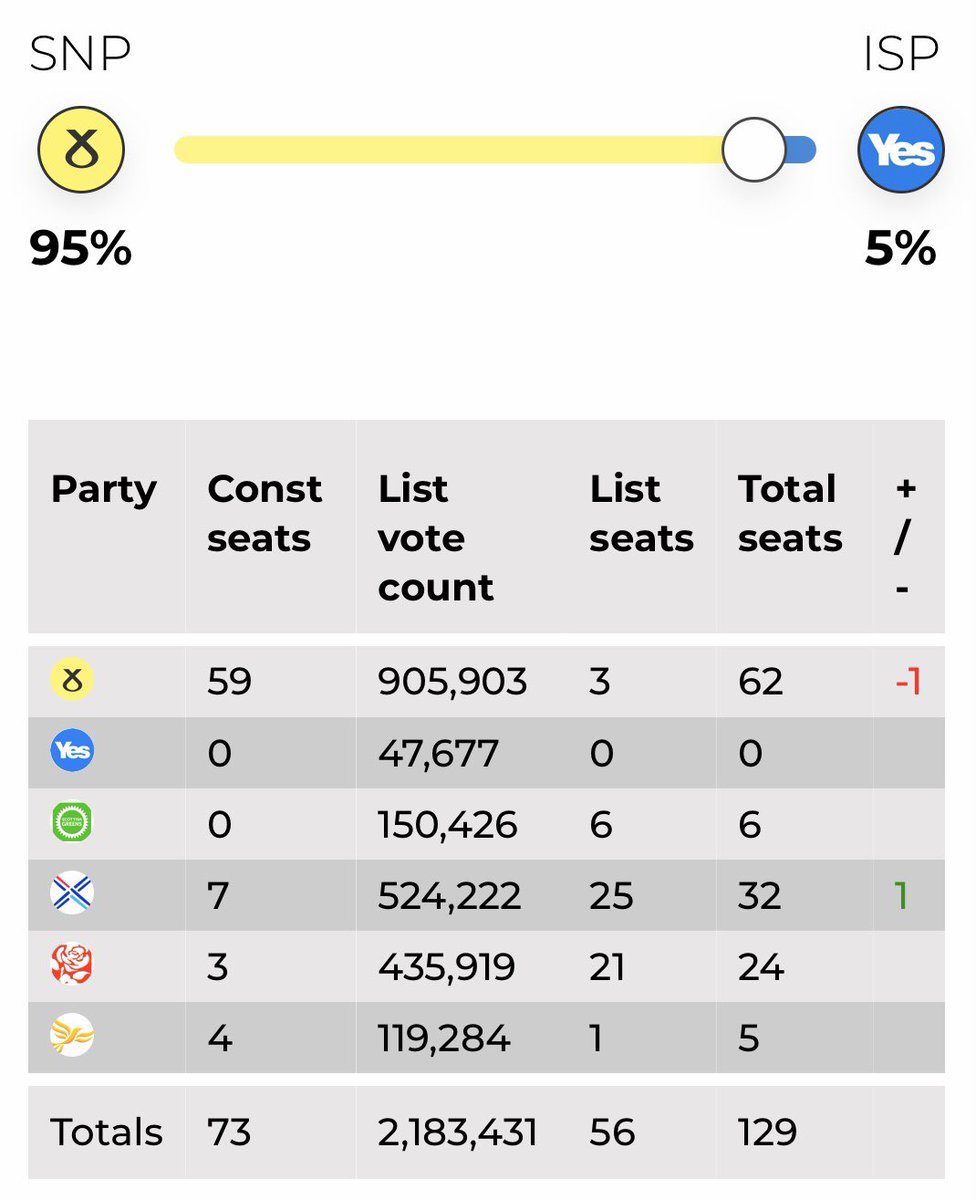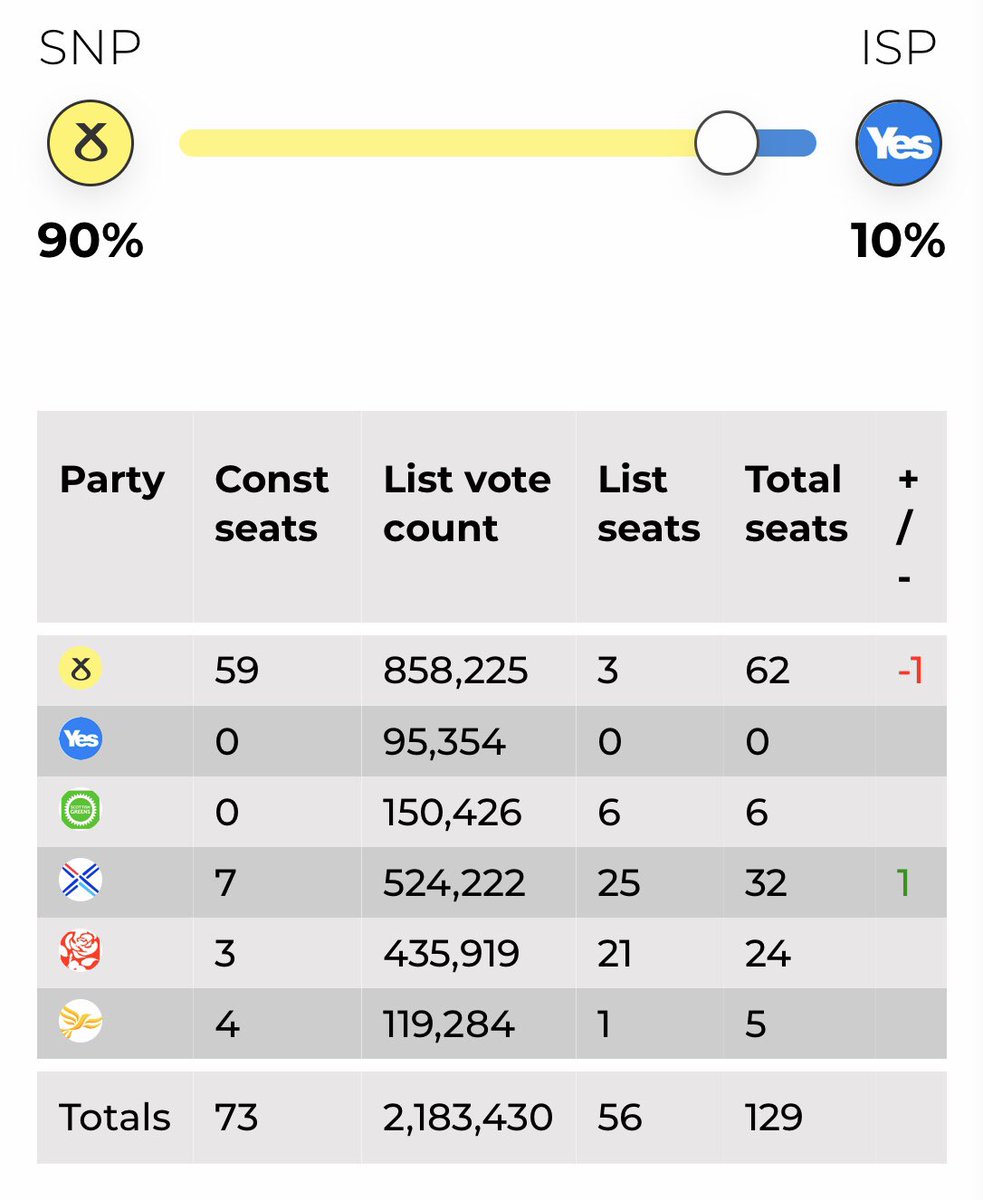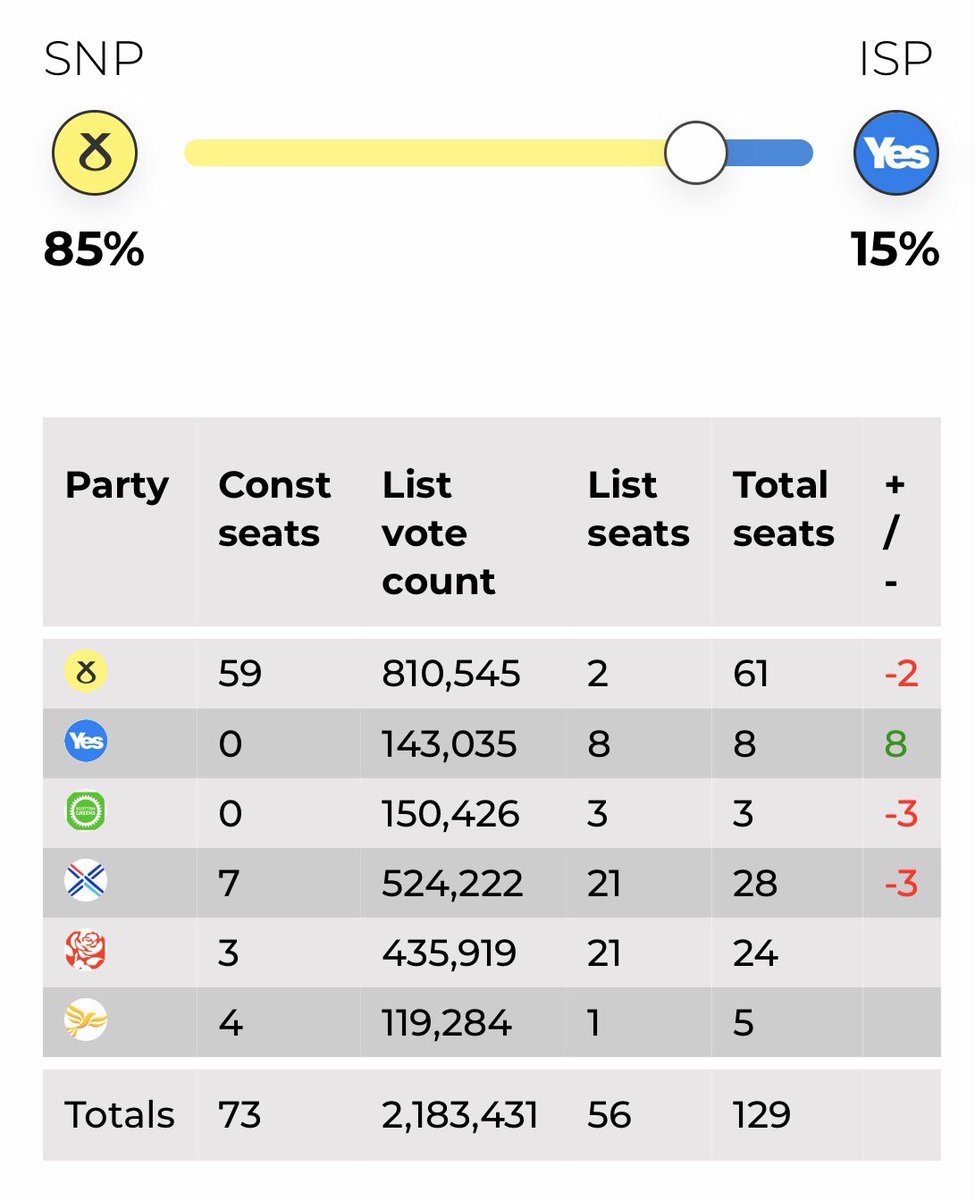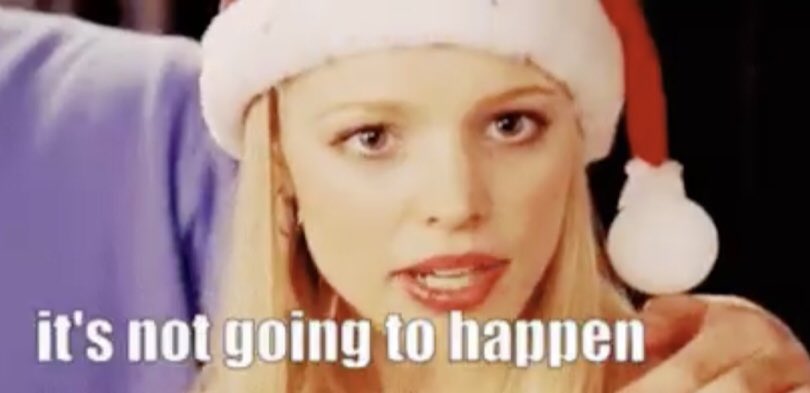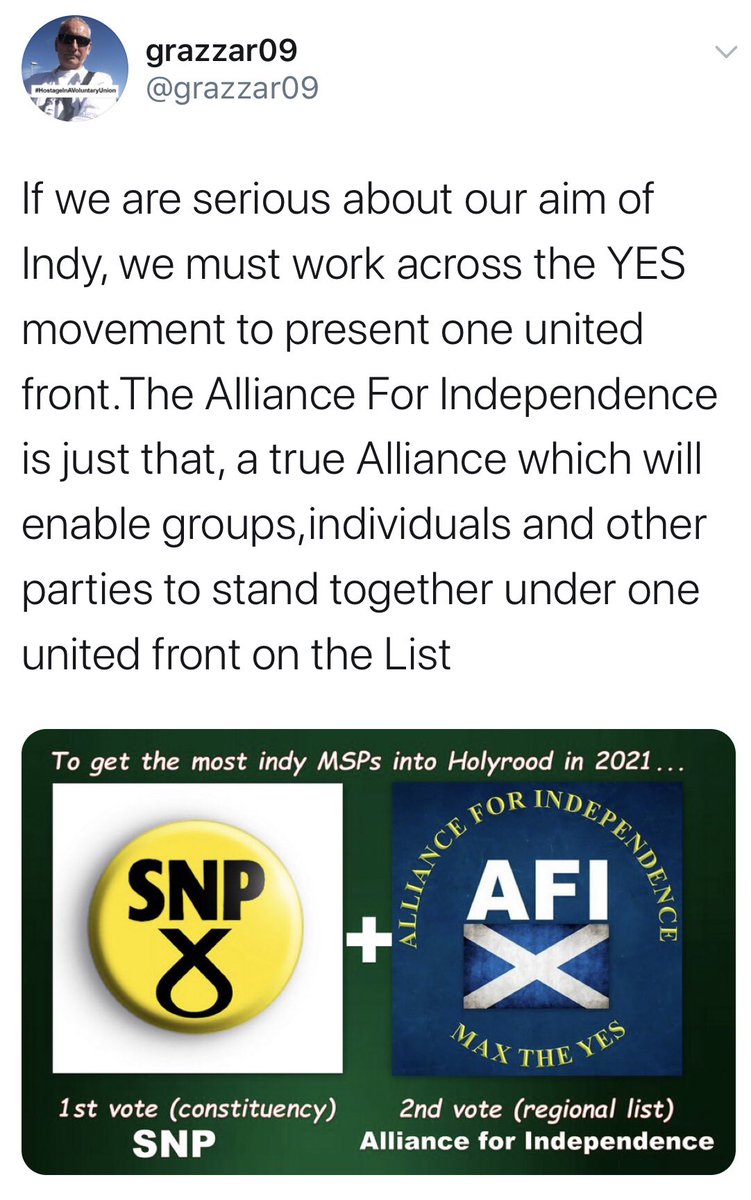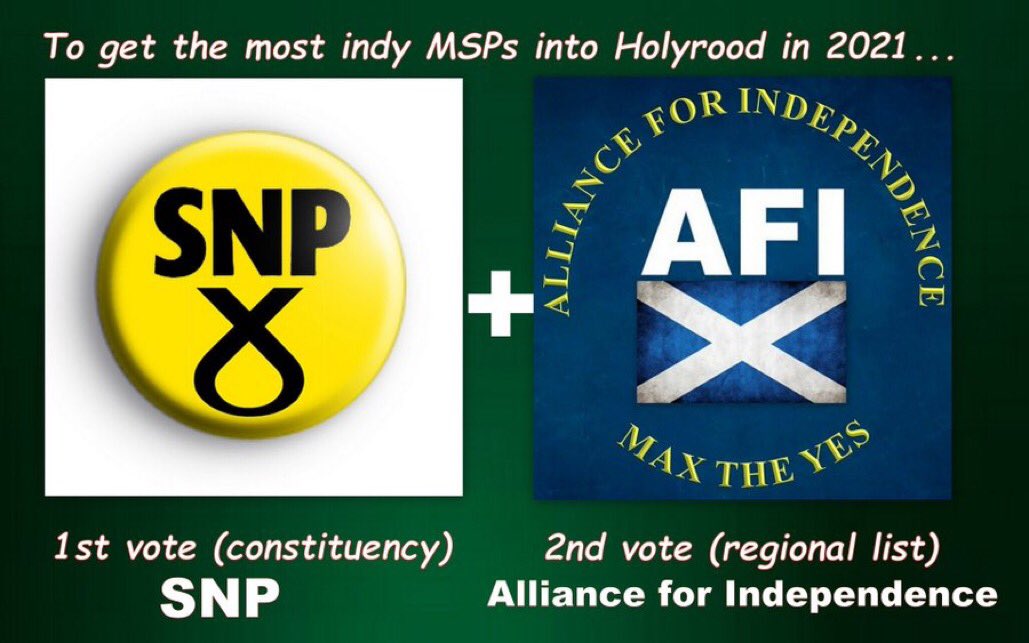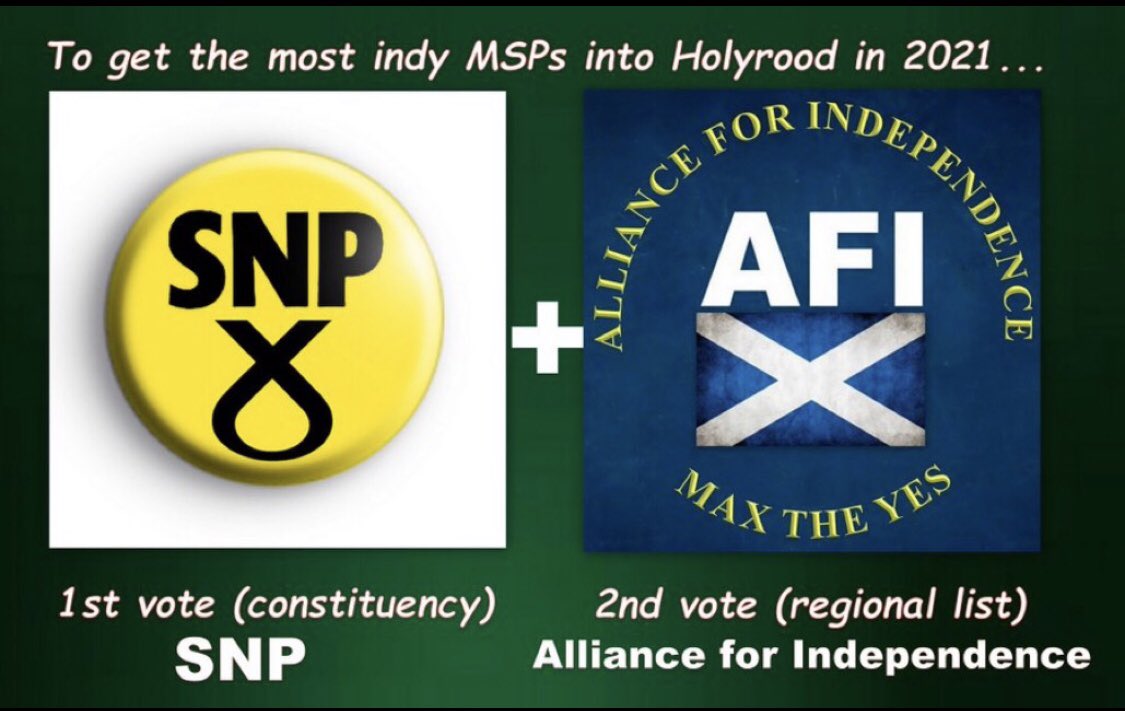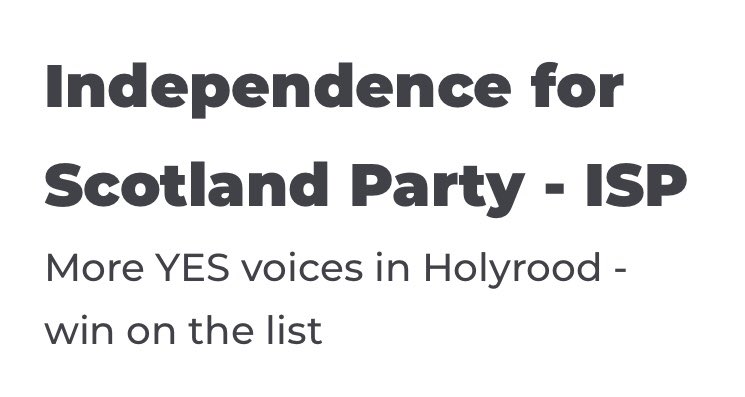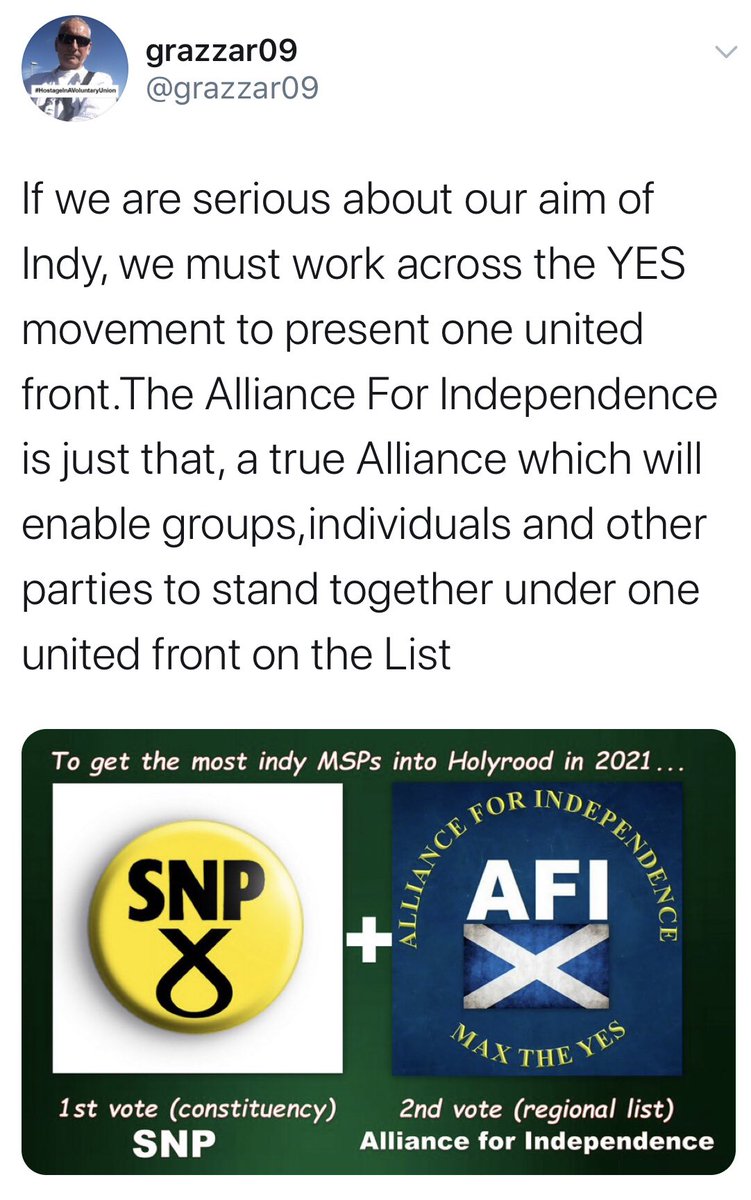“Playing with fire - or trying to game the list vote in #Holyrood2021 election.”
There’s been increasing discussion about how to maximise the number of seats for pro-indy parties in next year’s election, with at least one ‘list party’ having already been set up 1/
There’s been increasing discussion about how to maximise the number of seats for pro-indy parties in next year’s election, with at least one ‘list party’ having already been set up 1/
The rationale is the SNP will pick up very few seats in the regional lists, because it will excel in constituency results (a consequence of d’Hondt AMS).
(Recent polling suggests the SNP will achieve another overall majority, so the below discussion may be largely academic.) 2/
(Recent polling suggests the SNP will achieve another overall majority, so the below discussion may be largely academic.) 2/
Some countries (Israel in past) had a next to non-existent % of vote *national* threshold to be eligible for seats (allowing for a multitude of small parties); others have an official threshold of 5% (Germany), which effectively penalises small parties which fail to meet it. 3/
The list operates on regional & not a national basis: while there is no official threshold, a party has to achieve a certain % (approx 5-8%) to win just 1 seat. Thus a list party cannot win a few seats on basis of 1-2% nationally: it has to achieve over 5% in each region. 4/
The fortunes of the Greens perfectly illustrates the effective threshold of about 5% to gain even one MSP, & over 10% to gain two:
Central 4.7% 0
Glasgow 9.4% 1
Highlands& Islands 7.2% 1
Lothian 10.6% 2
Mid Scot & Fife 6.1% 1
NE Scot 4.9% 0
South Scot 4.7% 0
West Scot 5.3% 1
5/
Central 4.7% 0
Glasgow 9.4% 1
Highlands& Islands 7.2% 1
Lothian 10.6% 2
Mid Scot & Fife 6.1% 1
NE Scot 4.9% 0
South Scot 4.7% 0
West Scot 5.3% 1
5/
Looking at the 2016 results, there were a variety of minor parties, but the ones that concern us here are the pro-indy ones: Greens, RISE and Solidarity. While the Greens got 6.6% of vote & 6 seats, the other pro indy parties Solidarity on 0.6% & RISE on 0.5% got zero seats.
6/
6/
Even if RISE and Solidarity weren’t separate parties, even if *all* the minor (non Green) parties votes were combined as a single pro-indy party, on a total of about 4.5% of the vote, it is pretty certain they would have failed to gain one single MSP. 7/
We are told a list party led by Alex Salmond will attract 20% of list vote. A big if, which polls will reveal. Assuming he does not, we are left with what looks like two or even three pro-indy list parties, all vying with each other to attain that vital 5% regional threshold. 8/
I would be very surprised indeed if any of these (currently very low profile) list parties attract anything more than 1-2% of the vote (even Solidarity, led by the redoubtable and very well known Tommy Sheridan, could only muster 0.6% nationally in 2016). 9/
Time to crunch some numbers.
Christopher Melville has helpfully set up this site, which will show conveniently show the effect of the shift of the SNP list vote to a single alternative list party, the ISP:
https://listvotescotland.com
10/
Christopher Melville has helpfully set up this site, which will show conveniently show the effect of the shift of the SNP list vote to a single alternative list party, the ISP:
https://listvotescotland.com
10/
Assuming effect is correctly calculated, it provides some interesting results.
My first observation is minimum % transfer modelled is fully 5%.
In light of above, this is likely to *vastly* overestimate % attained by even one extra list party (realistic figure: maybe 1%). 11/
My first observation is minimum % transfer modelled is fully 5%.
In light of above, this is likely to *vastly* overestimate % attained by even one extra list party (realistic figure: maybe 1%). 11/
So let’s look at the minimum percentage vote needed in each AMS electoral region (remember there is no national list) for the ISP to achieve one single MSP, and the effect it has on the other parties (particularly, and most importantly, the SNP). 12/
Starting with Central and Glasgow: a whopping 15% movement from SNP to ISP is required to gain one MSP in each region, both coming at the expense of the Tories. 13/
In the Highlands and Islands, only a 5% swap from SNP to ISP will mean the *Tories* gaining a seat from the SNP! It requires fully a 15% movement from SNP to ISP to give it just one MSP...at the expense of the SNP. An own goal either way. 14/
In both Lothian and Mid Scotland & Fife, again, a whopping 15% swing from the SNP is required for the ISP to gain just one seat....both at the expense of the Greens. Another own goal in each. Three own goals now. 15/
In North East Scotland, an ISP seat finally again comes at the expense of a unionist party - the Tories - but again requiring a wholly unrealistic 15% from the SNP list vote. 16/
In the South of Scotland, again, an amazing 15% required for the ISP to gain a single seat...from the SNP. A fourth own goal. 17/
Lastly, in the West of Scotland, again 15% required for the ISP to gain just one seat...from the Greens this time. Own goal number five. 18/
So what have we learned from this?
On an overly optimistic move of 5% of the SNP vote to the ISP, the SNP will lose one MSP to the *Tories* in Highlands & Islands.
Same result with a 10% swing: zero ISP MSPs elected, and one more unionist Tory at the expense of the SNP. 19/
On an overly optimistic move of 5% of the SNP vote to the ISP, the SNP will lose one MSP to the *Tories* in Highlands & Islands.
Same result with a 10% swing: zero ISP MSPs elected, and one more unionist Tory at the expense of the SNP. 19/
On 15% movement from SNP required to elect one ISP in all 8 regions, state of play is:
SNP -2
Green -3
ISP +8
Con -3
Pro indy +5
Pro-union -3
(2 seats unaccounted for presumably because of algorithmic simplicity on the site: not sure if it computes effect on all parties.) 20/
SNP -2
Green -3
ISP +8
Con -3
Pro indy +5
Pro-union -3
(2 seats unaccounted for presumably because of algorithmic simplicity on the site: not sure if it computes effect on all parties.) 20/
Here are Scotland wide changes predicted. Unless a single (not two or more) pro-indy list party (here ISP) can be assured of 15% of the list vote in each region, there will be *no benefit* to not voting SNP/Green in list (indeed, at <15%, it could lead to loss of SNP seats). 21/
On this model, the ISP would need to have taken 30% of the SNP vote just to provide more than a net swap of 3 unionists to 3 pro-indy MSPs. This would mean slashing the SNP list vote beyond any credible expectation. Sorry folks:
A recent ‘poll’ was published boosting the fortunes of a new fifth pro indy list party - the ISP - by BfS. This purports to show that fully 57% of SNP voters are open to voting ISP on the list. https://www.businessforscotland.com/7700-independence-supporter-mega-poll-57-of-snp-voters-open-to-tactical-voting-on-list/
But be aware - as BfS itself admits - that this was an *entirely self selecting online* poll: in other words utterly worthless as a true indicator of likely support. Considering so many indy activists on Twitter seem to hate the SNP, it’s hardly surprising it seems unrealistic.
It’s quite concerning so many indy supporters here are planning to vote for minor list parties. If polling showed them taking 30% of list vote, that would be different matter, but voting for a party unlikely to get more than 1% of the vote will only harm chances of indy majority.
Here’s another pop up list party: if this is on the ballot paper as well as ISP, it further lessens the change of any list only party hitting that crucial 5% threshold. Unfortunately, a vote for anything other than the SNP or Greens will be a vote wasted and could help unionists.
We have to be sensible & guided by the facts here.
Even I was intrigued by the merits of the argument for voting for a list party because a ‘list SNP vote is wasted’.
It *seems* to make perfect sense.
But when you look at the actual modelled predictions it absolutely doesn’t.
Even I was intrigued by the merits of the argument for voting for a list party because a ‘list SNP vote is wasted’.
It *seems* to make perfect sense.
But when you look at the actual modelled predictions it absolutely doesn’t.
If there is a Salmond led party shown consistently to command a good 30% in the polls, that will of course be a game changer in terms of getting list seats: but it will likely only add to an overall majority achieved by the SNP, based on current polling.
As it is, it looks like Solidarity, RISE, ISP and now AFI fighting for maybe max 0.5% of list vote each, not only destroying the chance of *any* third pro-indy party gaining a seat, but maybe stopping the SNP or Greens getting one more seat, and seeing it go to unionists instead.
Just stop a minute & think.
Parties with no profile, no well known leaders, no funds & no members are going nowhere, especially not starting from scratch months before the election.
Before you are tempted to vote for one, think why even Tommy Sheridan mustered only 0.6% in 2016
Parties with no profile, no well known leaders, no funds & no members are going nowhere, especially not starting from scratch months before the election.
Before you are tempted to vote for one, think why even Tommy Sheridan mustered only 0.6% in 2016
Some salient points in Calum Winter’s letter here: https://www.thenational.scot/news/18575168.kenny-macaskills-suggestion-vote-snp-s-rivals-galling/
Even worse than I thought. We’re entering ‘People’s Front of Judea’ territory here, with now 3 indy list parties, on top of SNP, Greens, Solidarity & RISE.
Question for list party supporters: which of these 3 do we vote for (bearing in mind unless it gets 5% it’ll get 0 seats):
Question for list party supporters: which of these 3 do we vote for (bearing in mind unless it gets 5% it’ll get 0 seats):
Here’s my (of course entirely unscientific and self selecting) poll for indy supporters:
Which party will you vote for in the list if not SNP/Greens?
(I’d add Solidarity and RISE too, but Twitter only allows four options.)
Pls RT for bigger sample.
Which party will you vote for in the list if not SNP/Greens?
(I’d add Solidarity and RISE too, but Twitter only allows four options.)
Pls RT for bigger sample.
Think how much difficulty Greens have in getting coverage in campaign, let alone charismatic Tommy Sheridan. Who honestly thinks these 3 list parties will get any profile outside social media bubble?
Unless anyone donates their lottery winnings to buy them publicity, they won’t.
Unless anyone donates their lottery winnings to buy them publicity, they won’t.
What on earth is the motivation for the SNP and Greens to enter into a ‘pact’ with tiny fringe parties likely to get 0.5%? It would only cost them seats. Insanity for them.
Anyway, electoral pacts between parties are illegal under election law, so is a non starter, I’m afraid.
Anyway, electoral pacts between parties are illegal under election law, so is a non starter, I’m afraid.
https://twitter.com/ballotboxscot/status/1272546273841885184?s=21 https://twitter.com/ballotboxscot/status/1272546273841885184
At the end of the day, it doesn’t matter what I believe, or you believe. It’s not about *belief*. All we can go on are the numbers, the past list results, & predictive modelling. Don’t take my word for it, look at the numbers. This research made me realise how clear cut it is.
For everyone’s convenience, I have reviewed the regional list results in every Holyrood election from 1999 to 2016.
*Not one seat* has ever been won on the list by a party achieving less than 5% of the regional vote (lowest was 5.1% for a Lib Dem in Central Scotland, 2007).
*Not one seat* has ever been won on the list by a party achieving less than 5% of the regional vote (lowest was 5.1% for a Lib Dem in Central Scotland, 2007).

 Read on Twitter
Read on Twitter